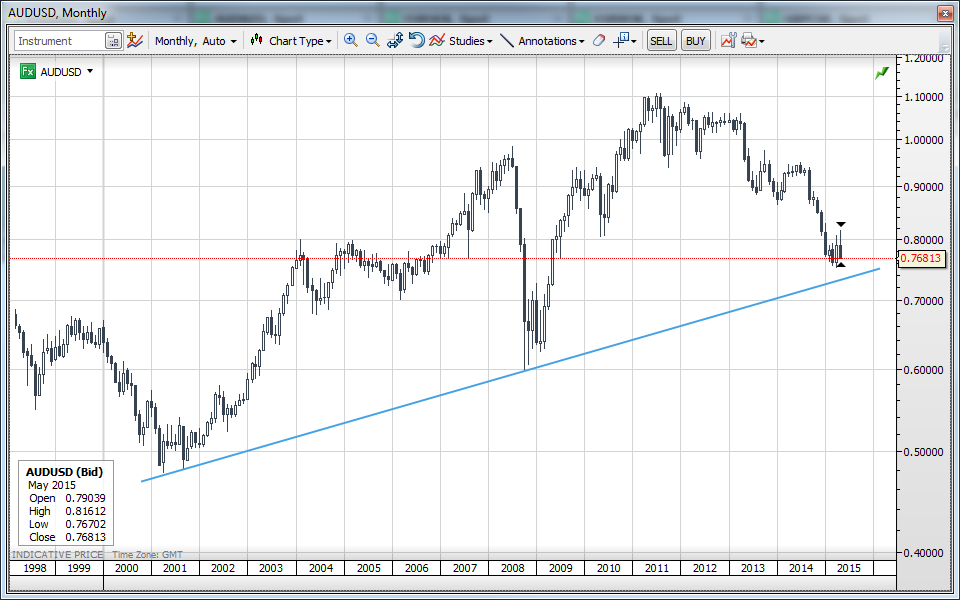USDJPY stretched to its highest level since 2002, just taking out the 2007 highs, but then corrected sharply back lower toward the end of the session as the move seems to be a bit too much, too soon. The reversal looks interesting in a number of other pairs, as well, like GBPJPY, where that pair has been toying with its highest levels since the financial crisis as well.
It’s far too early to call an end to the JPY sell-off, but let’s watch how the major JPY crosses deal with this consolidation after the recent big break of the 122.00 resistance in USDJPY. Japan’s Chief Cabinet Secretary Yoshihide Suga was out verbally intervening overnight as USDJPY was posting new highs, saying that sudden FX movements are undesirable.
Yesterday reminds us that we will remain the victims of ad hoc headline risks from Greece until some kind of more durable “deal” between Greece and its creditors puts a lid on the situation. Yesterday, it was news from a Greek official that a draft of an agreement was being drawn up that stimulated a bit of EUR buying after EURUSD touched its lowest level in a month.
German finance minister Schaeuble was out yesterday expressing surprise that Greek officials were communicating anything positive about the ongoing talks as there hasn’t been much progress. This issue is clearly far from resolved.
Overnight, a very weak Australian capital expenditures data point hit AUD across the board as this is a sensitive area for Australia’s heavily mining-investment and commodity-dependent economy. The number, at -4.4% year-on-year, saw the worst drop since 2009. This could be a leading indicator on a dovish leaning Reserve Bank of Australia at next Tuesday’s meeting as well.
AUDUSD - monthly chart
AUDUSD continues to trade heavily ahead of next Tuesday’s RBA meeting, as the overnight CapEx data raises expectations that the RBA will err on the dovish side in its guidance. We’re still some way from the lows below 0.7550 (though not if we look at a monthly chart like the one below), but a fresh wave of USD strength, for example on positive US data next week, could see the pair suddenly trading down to the lowest levels since 2009. Note the huge trendline from all the way back in 2001 - closer using the log scale than on a regular scale.

The G-10 rundown
USD: A bit of a pause in the strength for the moment – though still strong versus the weak commodity currencies at the moment. Traders may be looking at Friday’s US Q1 GDP revision, which is expected to be steeply negative, although next week’s key US economic data points for May are vastly more important in the bigger scheme of things.
EUR: Correcting a bit higher and there may be potential for a test of the key 1.1000/50 resistance zone before we revert to selling again. Constant risk of Greece-related headlines that could take the action either way.
JPY: Some verbal intervention from Japan after the latest move, which does look a bit overdone, given the lack of evident drivers. The key pair to watch remains USDJPY, where the upside remains the focus as long as we remain above the 122.00 area on closing levels.
GBP: GDP revision is up today as the sterling rally is showing signs of fading in some of the crosses. Still focusing lower in GBPUSD and interesting to watch whether outperformance versus the EUR fades here as well, though EURUSD and EURGBP may remain correlated.
AUD: Weak on ugly CapEx data in Q1 and may remain weak as RBA may lean to the dovish side at its meeting next Tuesday on this kind of data. AUDCAD is a potentially interesting alternative to AUD downside to AUDUSD.
CAD: A very gentle and orderly consolidation thus far as the recent rally looks very credible and able to sustain some consolidation lower without threatening the upside bias. A move above 1.2500 from here fully re-engages the bullish outlook.
NZD: Pulled stronger against the AUD on the ugly Australian data, but very important bearish catalyst for NZDUSD awaits down below 0.7200 if the USD remains strong here.
SEK: Yesterday’s rally spoiling expectations for more SEK appreciation – so defaulting back to the weak side on the aggressiveness of the Rikbank’s dovishness.
NOK: Interesting data up tomorrow and oil is sharply weaker over the last couple of sessions, so leaning to the weak side, particularly if the unemployment rate remains at the elevated 3.0% level or worse rather than falling to the expected 2.9%.
Economic Data Highlights
- Japan April Retail Trade out at +0.4% MoM versus +1.1% expected and Retail Trade out at +5.0% YoY versus +5.5% expected
- Australia Q1 Private Capital Expenditures out at -4.4% QoQ versus -2.2% expected
Upcoming Economic Calendar Highlights (all times GMT)
- UK Q1 GDP Revision (0830)
- UK March Index of Services (0830)
- Euro Zone May Industrial, Economic, Services, Consumer Confidence Survey (0900)
- Canada Q1 Current Account Balance (1230)
- US Weekly Initial Jobless Claims (1230)
- US April Pending Home Sales (1400)
- US Fed’s Kocherlakota to speak (1845)
- New Zealand April Building Permits (2245)
- UK May GfK Consumer Confidence (2305)
- Japan April. Jobless Rate (2330)
- Japan April Overall Household Spending (2330)
- Japan April National CPI (2330)
- Japan April Industrial Production (2350)
- Australia April HIA New Home Sales (0100)
- New Zealand May ANZ Business Confidences/Activity Outlook (0100)
- Australia April Private Sector Credit (0130)
